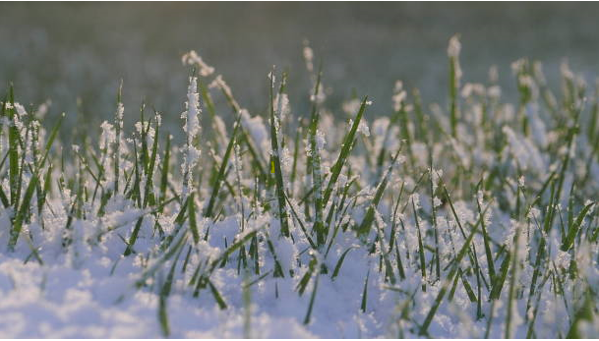Winter ready: how to prepare your garden for the cold months?
How do I prepare my garden in a sustainable way?
- Compost turnover
Winter may not seem like the best season for composting, but it comes with its own perks. Use the summer compost to cover vulnerable plants and fill the compost stash with any uprooted annual flowers, clippings and fallen fruits. This way you will start spring in your garden with a fresh batch of compost to give your plants a much needed boost.
- Leave the leaves
While it may be tempting to rake all the fallen leaves and enter the winter hibernation with a clean slate, leaving leaves comes with multiple benefits. Not only it provides shelter for the wildlife, but also the slow decay nourishes the soil, improves the diversity of microorganisms and slows down growth of weeds.
- Uproot and de-bulb
Plenty of plants can get through the winter with just a bit of help in the form of fleece wrapping and mulch covering the roots. Some however need to be uprooted, potted and moved indoors. You can also remove the bulbs from soil and keep them in a cool, dark place for spring planting.
- Prune & weed
Not all plants enjoy the autumn pruning (so please do a quick research before the big clean-up), but for those that do, a quick trim before the winter can help withstand strong winds and make bouncing back to life in the springtime a breeze. Autumn and winter are also the perfect time to finally tackle the pesky weeds or brambles overgrowing your garden. Weeds can survive perfectly well in a compost file, so we advise shredding them before composting or even packing into green waste bags and disposing of.
- Collect rainwater
If you have space for a barrel, autumn and winter months are the perfect time to collect some rainwater for dryer spring and summer. Make sure the barrel is covered so that fallen leaves don’t decay in water, and wildlife is not getting trapped in it trying to get a sip.
Top 10 plants that need a little help with getting through the winter.
Tip: horticultural fleece lets in light, air and water at the same time as providing vital insulation.
- Agapanthus (African blue lily)
Ideally you would keep it in pots that you can move indoors for the winter. Alternatively, wrap in fleece and generously cover the base in mulch.
- Banana
Some types of bananas can withstand temperatures down to -5, but need their roots covered in mulch and crowns wrapped in straw or fleece. Other, more sensitive species like Ensete ventricosum need to be moved into pots and kept indoors.
- Canna
Cannas overwinter underground as rhizomes. A thick duvet of mulch helps insulate
against frost. In colder areas, lift plants in autumn, pot up and keep frost-free and barely
watered until spring. Harden off before planting out in late May.
- Cordyline (Cabbage palm)
The colour is the guide: plain green and those with cream variegations tend to be tougher than those with striped or red-tinted leaves. Tie the leaves upright and insulate with fleece or hay.
- Echium pininana
As they’re native to Madeira and Canary Islands, those plants like mild climates. However, they also need to reach a certain size to bloom, making it rather impractical for potting and keeping indoors. To solve this issue, wrap your echiums in a double layer of fleece, potentially with some straw in between the layers for extra insulation, and make sure that they’re protected from the harshest winds (you can tie them to a pole to provide additional support).
- Melianthus major (Honeybush)
Honeybush deals with cold rather well, however, actual frosty conditions may pose danger to it. A decent, tight fleece wrapping will protect it through winter.
- Olive
If small enough, pot and move indoors (doesn’t need to be in a heated area, a garage will be just fine). Larger specimens will enjoy windbreaks and fleece coating.
- Pelargonium
Necessary to move indoors or into a greenhouse. Optionally, you can take cuttings, pot them and replant for spring.
- Pineapple lily
Preferably move indoors, but a thick layer of mulch and a tight wrapping with hessian will do the trick.
- Tree fern
Large tree ferns should be wrapped up for the winter. Either cover the crown by bending old fronds over it, fill it with straw or put a cap of fleece over it. Or wrap the entire plant in hessian.
What about the polytunnels?
When it comes to polytunnels, you can adapt different approaches depending on your needs.
If the last few growing seasons were intense, you may choose to clear out the tunnel, mix the soil with compost and leave it to rest in order to regenerate. Or, you may choose to go 50/50 – leave half of the beds to regenerate and use the other half for planting. Finally, you may simply keep on growing produce throughout the winter, albeit it has different rules than summer polytunnel gardening.
Even on sunny days, the polytunnel in winter does not get warm enough to grow crops such as tomatoes or peppers, and shorter days pose another challenge. What makes polytunnel a fantastic tool in winter is “extending the season”. You can save yourself a lot of spring work by planting vegetables like garlic, leafy greens or beetroots in late August or October. They most likely won’t grow big enough for actual consumption during the cold months (maybe apart from some fast growing leafy greens like chard), however, they will have a head-start on growing and hence when the weather gets warmer, they will produce bigger crops, faster.
Last but not least, if your tunnel is situated in a place where it gets sunlight from most angles as the sun moves, you can invest in a propagator heat mat and use your polytunnel as a winter seed nursery.
Happy gardening!
Sources:
https://www.housebeautiful.com/uk/garden/seasons/a37948735/sustainable-prepare-garden-winter/
https://greensideup.ie/looking-after-planting-a-polytunnel-in-winter/
https://www.gardenersworld.com/plants/10-plants-to-protect-over-winter/
https://www.nwf.org/Magazines/National-Wildlife/2015/OctNov/Gardening/Leave-the-Leaves
https://learn.eartheasy.com/articles/ten-ways-to-prepare-your-garden-for-winter/






Leave A Comment